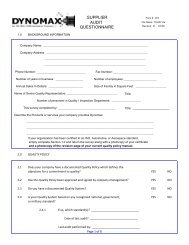You also want an ePaper? Increase the reach of your titles
YUMPU automatically turns print PDFs into web optimized ePapers that Google loves.
Contact Seals<br />
Only in the case of relatively small diameters and relatively small rotational speed, is it possible<br />
to use a contact seals.<br />
The lip of a radial shaft seal must always exert a certain pressure on the counterface to obtain<br />
efficient sealing. The friction resulting from this lip pressure is only part of the total friction in<br />
the contact and thus of the total power loss at the sealing position. The other contributing<br />
factors include<br />
– the type of medium being sealed<br />
– the pressure differential across the seal<br />
– the circumferential speed<br />
– the surrounding temperature<br />
– the lubrication<br />
– the condition of the counterface<br />
Figure 27 illustrates the frictional losses that<br />
may be expected when a radial shaft seal with<br />
conventional sealing lip is properly installed<br />
and fully lubricated.<br />
During the running-in phase for the sealing<br />
lip, which lasts a few hours, the frictional<br />
losses are somewhat higher.<br />
For the seals intended for high pressure<br />
differentials, the losses are generally higher<br />
than shown in the diagram. For Waveseal<br />
designs, on the other hand, the losses are<br />
generally lower than indicated.<br />
Permissible speeds<br />
Guideline values for the permissible<br />
rotational and circumferential speeds for<br />
the different Contact seal designs are given<br />
on Figure 28.<br />
It will be seen in Figure 29 that higher<br />
circumferential speeds are permitted for<br />
large-diameter shafts but not for shafts with<br />
smaller diameters. This is because the cross<br />
section of the shaft does not increase<br />
linearly with the increase in diameter but by<br />
the square of the increase in diameter, so<br />
that the heat removal capacity of a large<br />
shaft is much better than a small shaft. The<br />
diagram gives circumferential and rotational<br />
speeds related to the material of the sealing<br />
lip.<br />
Figure 27. Contact Seal Frictional loss<br />
Figure 28. Permissible circumferential<br />
speeds for various seal designs<br />
- 28 -



